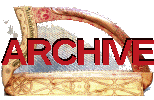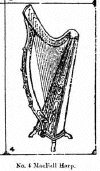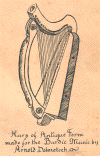
|
We have already seen how in the 19th century a new type of harp (known today as "Irish harp", or "clarsach", or "Celtic harp", or "lever harp", or sometimes "folk harp") was developed, and how it competed with and overcame the Gaelic harp. Nevertheless there were sporadic attempts to make and play early Gaelic harps.

MacFall
"Tara"
(JO'L 1903)
James MacFall was a Belfast furniture maker who started making small Irish harps in about 19021. His design, the "Tara harp" (which is still copied today) owes much to the European classical tradition, with its pedal-harp style soundbox and semitone mechanisms, but the outline and decoration was an exuberant piece of early 20th Century Gaelic revival design. Although usually strung with gut, in the classical (and modern Irish) tradition, they were offered for sale with the option of wire strings in the historical style2. James O'Laverty was keen that the ancient wire stringing tradition should be promoted, but nothing lasting seems to have come of it.

Dolmetsch
harp
(AD 1937)
In the 1930s Arnold Dolmetsch, working in England, became interested in the medieval Welsh harp music preserved in Robert ap Huw's seventeenth century manuscript3. Dolmetsch worked on the tablature and produced "translations" into staff notation. He also made some harps based on the surviving Irish and Scottish instruments. Although he was the first to apply historical methods to the making of early Gaelic harps, he nonetheless applied contemporary Celtic harp principles to the designs, presumably assuming that they preserved ancient traditions. Some of his harps were strung with gut and some with wire. His wife, Mabel Dolmetsch, recorded a selection of the pieces using reconstructed fingernail techniques in 19374.
In Brittany there was an upsurge of interest in all things Celtic, including the ancient and modern harp traditions of Ireland and Scotland. Alan Cochevelou (later known as Stivell) was classically trained but his father made him a lever harp; his first recording5 was made in 1959. In 1964 his father made another instrument, this time with metal strings, and it was this one that Alan played on perhaps his best known and most influential record Renaissance de la Harpe Celtique. Gildas Jaffrennou, also a Breton, studied harp making with the Dolmetschs and included a modern neo-medieval style wire-strung harp in his 1973 textbook on folk harp making6.
Some of the wire-strung harps that Dolmetsch had made were taken to Scotland. Edith Taylor, the first honorary secretary of Comunn na Clàrsaich, had one7, and so too did the notable harpist Heloise Russell-Fergusson8, although the latter preferred to perform on an American gut-strung harp made by Clarke9. Mary Rowland in the 1950s and 60s had a harp made by Briggs of Glasgow10, which she had restrung with "metal strings in the ancient minstrel style"11, and played with her nails. She recorded an LP for the BBC in 196012, which included a performance of Scott's Lamentation (from Edward Bunting's collection), and in 1961 she was invited to play on the 15th Century Trinity College harp, which had just been restored by the British Museum and restrung with brass wire by Joan Rimmer. This too was recorded by the BBC13.
The BBC's broadcast of the Trinity College harp being played had a big impact on certain people in Ireland, where the sound of its brass strings and willow soundbox were a revelation. Gráinne Yeats, who was a professional player of the gut-strung harp, spent many years trying to get an Irish harp maker to build her an early Gaelic harp14.
It must be remembered that these are merely obscure sidelines in the making and playing of Celtic harps in the 20th century. Many thousands of people were playing lever harps with gut strings, some enjoying their contemporary possibilities and others believing they were playing an instrument unchanged for centuries if not millennia. Although some people were undoubtably using historical methods in making and playing their harps, the genuine revival of the historical Gaelic harp tradition did not start until the 1970s.